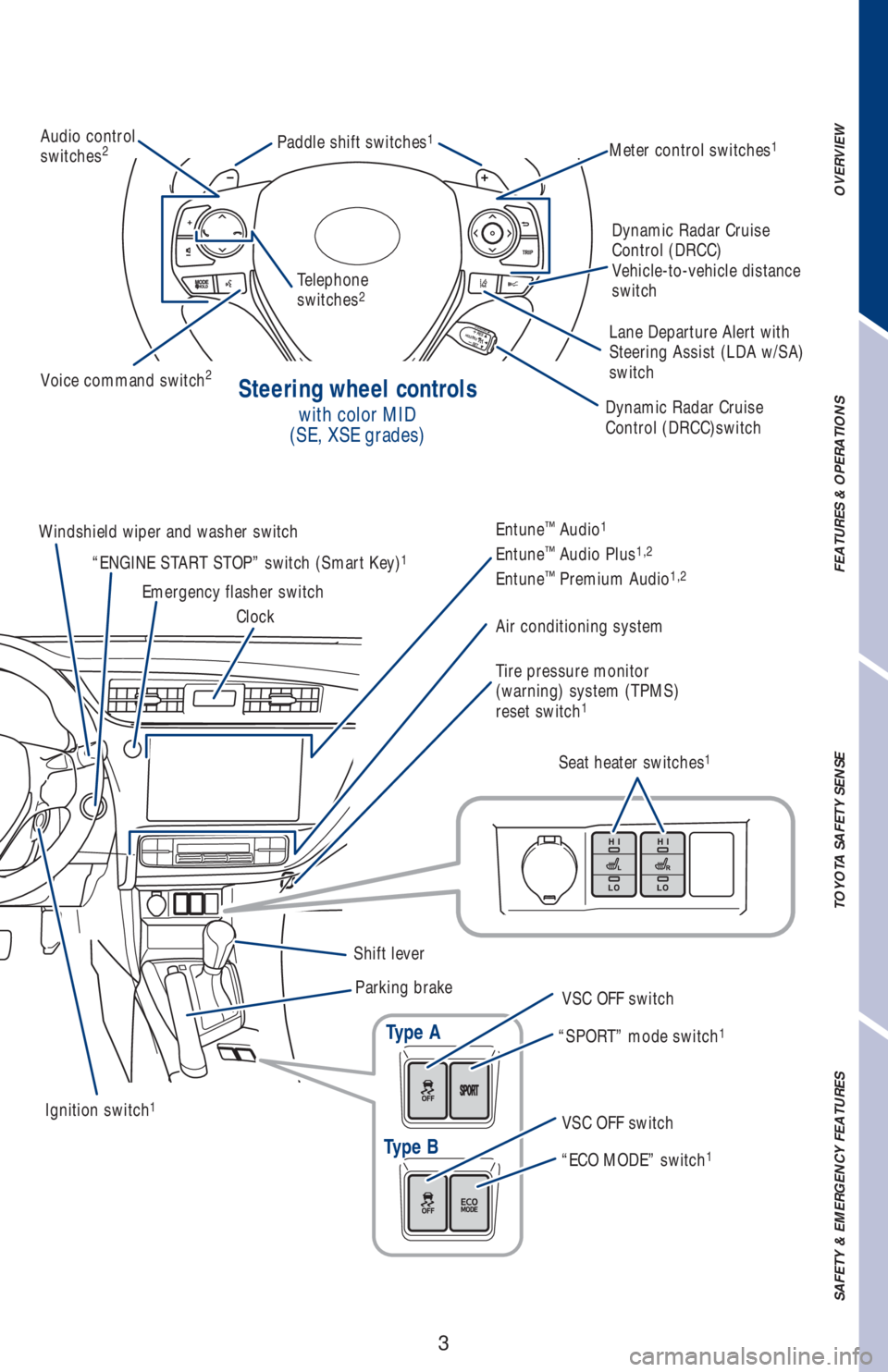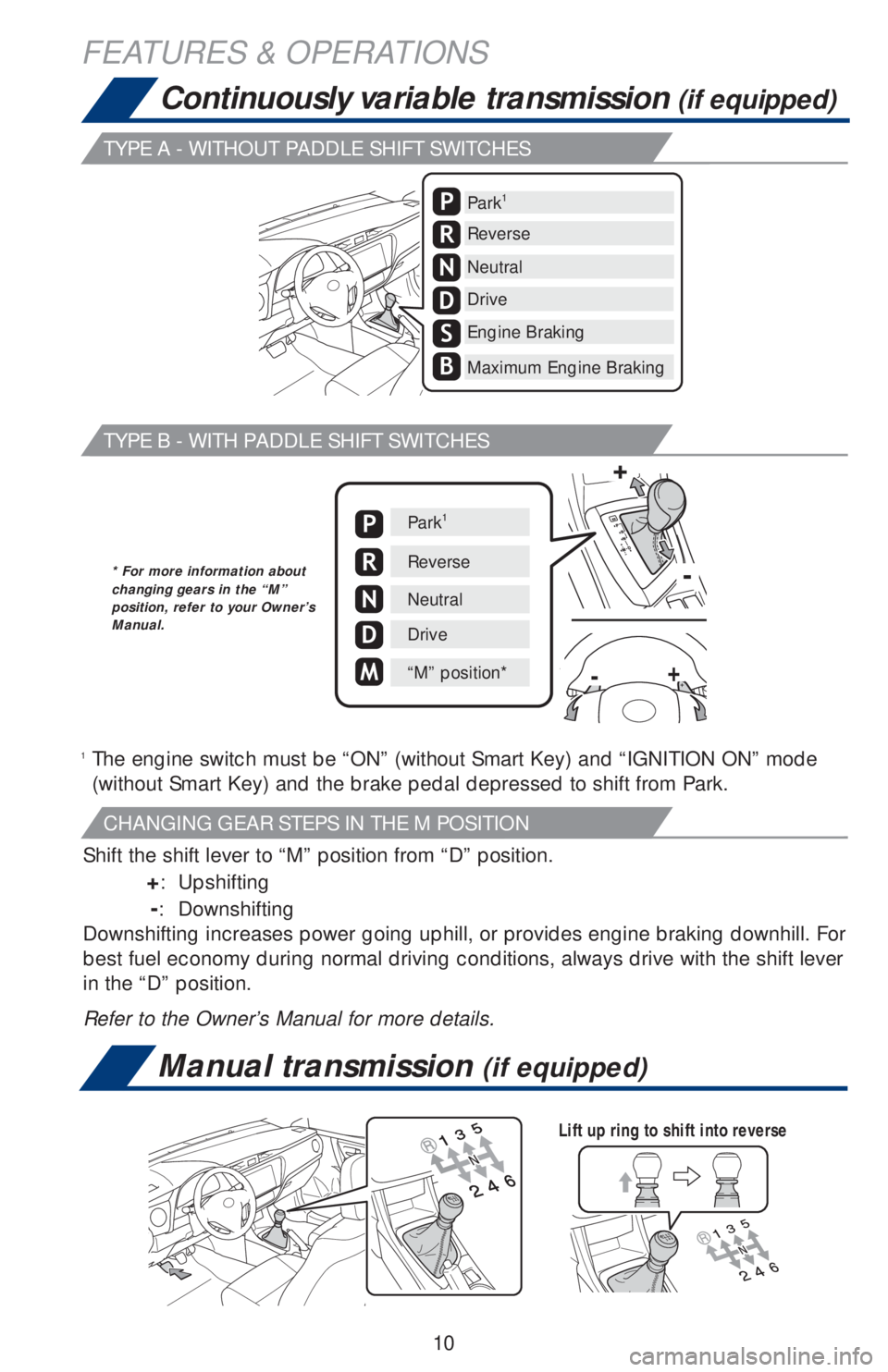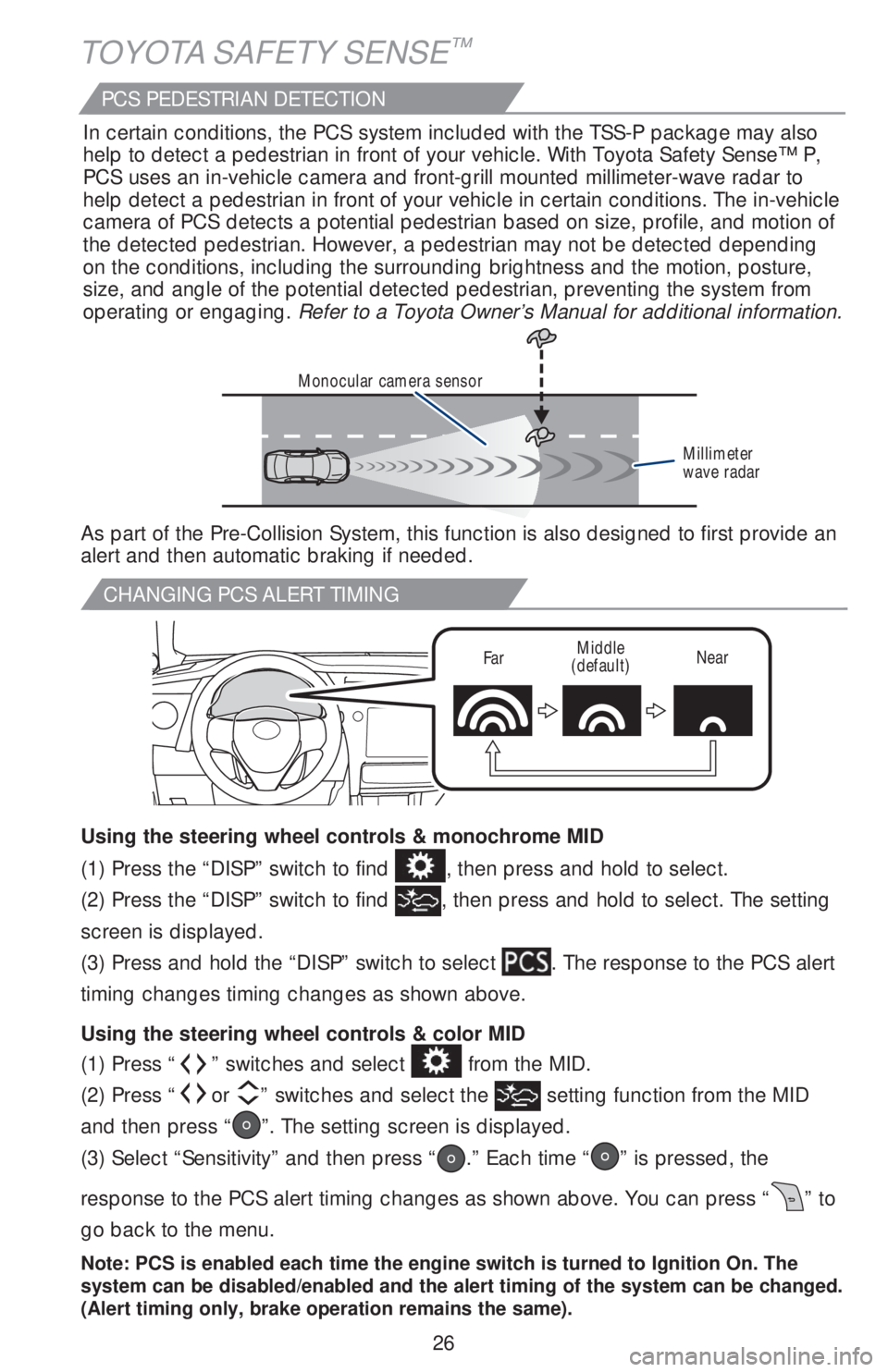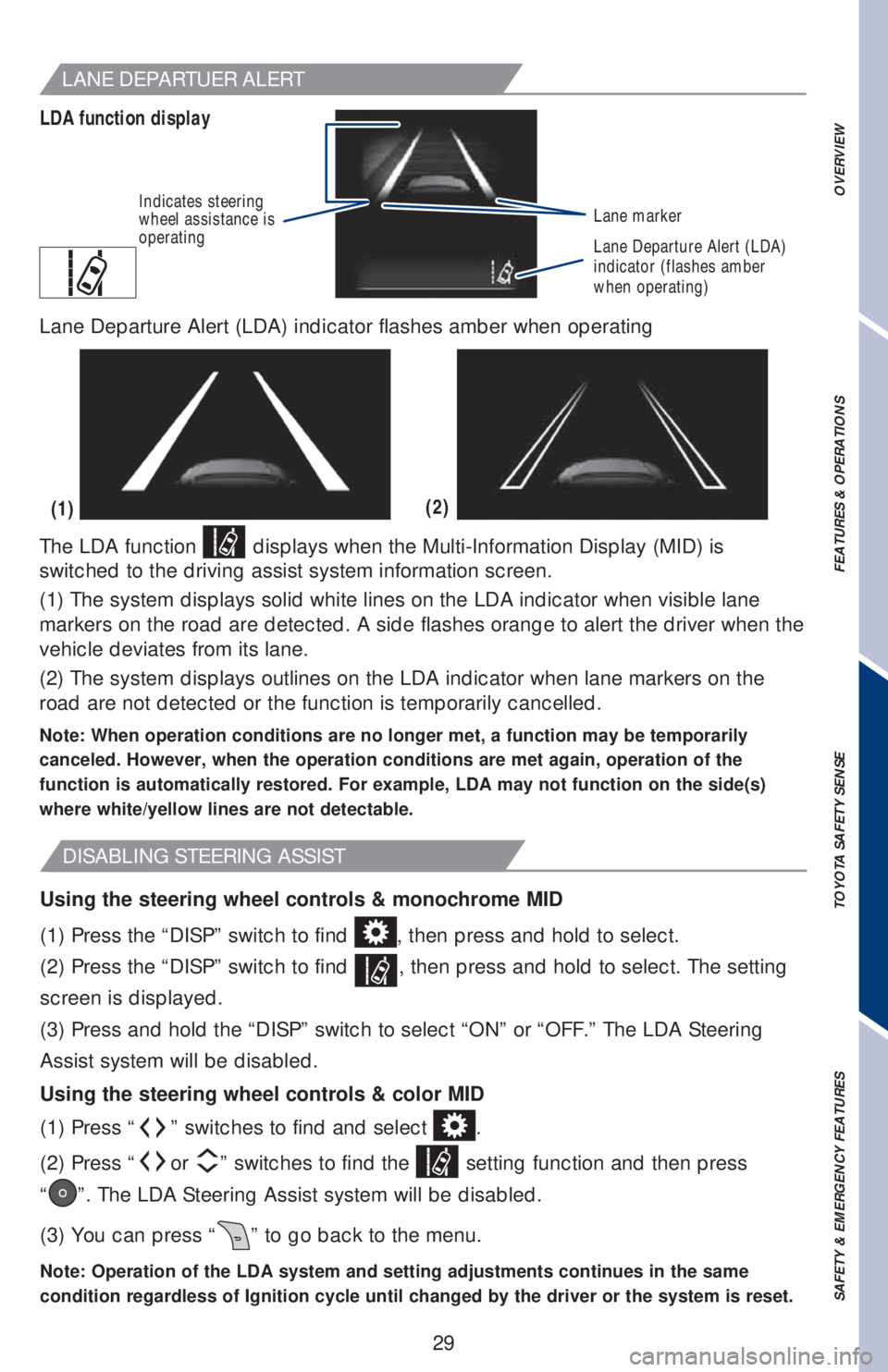2019 TOYOTA COROLLA ignition
[x] Cancel search: ignitionPage 5 of 56

3
OVERVIEW FEATURES & OPERATIONS TOYOTA SAFETY SENSE SAFETY & EMERGENCY FEATURES
Steering wheel controls
with color MID
(SE, XSE grades)
Type A
Type B
Audio control
switches2Meter control switches1Paddle shift switches1
Voice command switch2
Dynamic Radar Cruise
Control (DRCC)switch
Ignition switch
1
Windshield wiper and washer switch
Emergency flasher switch
ClockEntune™ Audio1
Entune™ Audio Plus1,2
Entune™ Premium Audio1,2
Air conditioning system
Tire pressure monitor
(warning) system (TPMS)
reset switch
1
Seat heater switches1
Shift lever
Parking brake
VSC OFF switch
VSC OFF switch “SPORT” mode switch
1
“ECO MODE” switch1
“ENGINE START STOP” switch (Smart Key)1
Telephone
switches2
Dynamic Radar Cruise
Control (DRCC)
Vehicle-to-vehicle distance
switch
Lane Departure Alert with
Steering Assist (LDA w/SA)
switch
Page 12 of 56

10
Manual transmission (if equipped)
Continuously variable transmission (if equipped)
Lift up ring to shift into reverse
Park1
Reverse
Neutral
Drive
Engine Braking
Maximum Engine Braking
S
B
P
R
N
D
1 The engine switch must be “ON” (without Smart Key) and “IGNITION ON” mode
(without Smart Key) and the brake pedal depressed to shift from Park.
Shift the shift lever to “M” position from “D” position.
+: Upshifting
-: Downshifting
Downshifting increases power going uphill, or provides engine braking downhill. For
best fuel economy during normal driving conditions, always drive with the shift lever
in the “D” position.
Refer to the Owner’s Manual for more details.
Park1
Reverse
Neutral
Drive
“M” position*
P
R
N
D
M
+
+
-
-
* For more information about
changing gears in the “M”
position, refer to your Owner’s
Manual.
FEATURES & OPERATIONS
TYPE A - WITHOUT PADDLE SHIFT SWITCHES
TYPE B - WITH PADDLE SHIFT SWITCHES
CHANGING GEAR STEPS IN THE M POSITION
Page 18 of 56

16
FEATURES & OPERATIONS
USB media port
By connecting a USB-compatible portable audio device or USB memory stick into
the USB media port, you can listen to music through the vehicle’s speaker system.
AUX port
By inserting an AUX cable into the AUX port, you can listen to music from a
portable audio device through the vehicle’s speaker system while in AUX mode.
The engine switch must be in the “ACC” or “ON” (without a Smart Key system),
ACCESSORY or IGNITION ON mode (with a Smart Key system) position for use.
Interval wipe Mist
Slow
Fast
Pull to wash and wipe
Windshield wipers & washers
* Intermittent windshield wiper frequency adjustment Rotate to increase/
decrease wipe frequency. (Available on select grades.)
Refer to the Owner’s Manual for more information.
Adjust frequency*
Pull to wash and wipe
Power outlet
USB media/AUX port
Page 21 of 56

19
OVERVIEW FEATURES & OPERATIONS TOYOTA SAFETY SENSE SAFETY & EMERGENCY FEATURES
Seat heaters (if equipped)
Driver seat Front passenger seat
The engine switch must be in the “ON” (without a Smart Key system) or “IGNITION
ON” (with a Smart Key system) mode.
WINDSHIELD WIPER DE-ICER (IF EQUIPPED)
Page 28 of 56

26
CHANGING PCS ALERT TIMING
FarMiddle
(default)Near
TOYOTA SAFETY SENSE™
(1) Press “” switches and select from the MID.
(2) Press “
or ” switches and select the setting function from the MID
and then press “
”. The setting screen is displayed.
(3) Select “Sensitivity” and then press “
.” Each time “” is pressed, the
response to the PCS alert timing changes as shown above. You can press “
” to
go back to the menu.
Note: PCS is enabled each time the engine switch is turned to Ignition On. The
system can be disabled/enabled and the alert timing of the system can be changed.
(Alert timing only, brake operation remains the same).
(1) Press the “DISP” switch to find , then press and hold to select.
(2) Press the “DISP” switch to find
, then press and hold to select. The setting
screen is displayed.
(3) Press and hold the “DISP” switch to select
. The response to the PCS alert
timing changes timing changes as shown above.
Using the steering wheel controls & color MID Using the steering wheel controls & monochrome MID
Monocular camera sensor
Millimeter
wave radar
As part of the Pre-Collision System, this function is also designed to first provide an
alert and then automatic braking if needed.In certain conditions, the PCS system included with the TSS-P package may also
help to detect a pedestrian in front of your vehicle. With Toyota Safety Sense™ P,
PCS uses an in-vehicle camera and front-grill mounted millimeter-wave radar to
help detect a pedestrian in front of your vehicle in certain conditions. The in-vehicle
camera of PCS detects a potential pedestrian based on size, profile, and motion of
the detected pedestrian. However, a pedestrian may not be detected depending
on the conditions, including the surrounding brightness and the motion, posture,
size, and angle of the potential detected pedestrian, preventing the system from
operating or engaging. Refer to a Toyota Owner’s Manual for additional information.
PCS PEDESTRIAN DETECTION
Page 31 of 56

29
OVERVIEW FEATURES & OPERATIONS TOYOTA SAFETY SENSE SAFETY & EMERGENCY FEATURES
(2)
(1)
The LDA function
displays when the Multi-Information Display (MID) is
switched to the driving assist system information screen.
(1) The system displays solid white lines on the LDA indicator when visible lane
markers on the road are detected. A side flashes orange to alert the driver when the
vehicle deviates from its lane.
(2) The system displays outlines on the LDA indicator when lane markers on the
road are not detected or the function is temporarily cancelled.
Note: When operation conditions are no longer met, a function may be temporarily
canceled. However, when the operation conditions are met again, operation of the
function is automatically restored. For example, LDA may not function on the side(s)
where white/yellow lines are not detectable.
DISABLING STEERING ASSIST
LANE DEPARTUER ALERT
LDA function display
Lane marker
Lane Departure Alert (LDA)
indicator (flashes amber
when operating)
Lane Departure Alert (LDA) indicator flashes amber when operating
(1) Press “” switches to find and select .
(2) Press “
or ” switches to find the setting function and then press
“
”. The LDA Steering Assist system will be disabled.
(3) You can press “
” to go back to the menu.
Note: Operation of the LDA system and setting adjustments continues in the same
condition regardless of Ignition cycle until changed by the driver or the system is reset.
(1) Press the “DISP” switch to find , then press and hold to select.
(2) Press the “DISP” switch to find
, then press and hold to select. The setting
screen is displayed.
(3) Press and hold the “DISP” switch to select “ON” or “OFF.” The LDA Steering
Assist system will be disabled.
Using the steering wheel controls & color MID Using the steering wheel controls & monochrome MID
Indicates steering
wheel assistance is
operating
Page 32 of 56

30
SWAY WARNING SYSTEM
SWS is a function of LDA and is designed to detect swaying based on the vehicle
location in the lane and the driver’s steering wheel operation. To help prevent
swaying, the system alerts the driver using a buzzer sound and a warning displays
in the MID.
Continuous lane deviations from
swaying.
Gentle swaying from driver’s
inattentiveness.
Acute steering wheel operation after the
number of operations decrease due to driver’s
inattentiveness.
ADJUSTING LDA ALERT SENSITIVITY
The driver can adjust the sensitivity of the LDA (warning) function from the
Multi-Information Display (MID) customization screen.
High - Is designed to warn approximately before the front tire crosses the
lane marker.
Normal - Is designed to warn approximately when the front tire crosses
the lane marker.
(1) Press “
” switches to find and select .
(2) Press “
or ” switches to find the setting function and then press
“
”. The setting screen is displayed.
(3) Select “Sensitivity” and then press “
.” Each time “” is pressed, the
response to the LDA alert sensitivity changes. You can press “
” to go back to
the menu.
Note: Operation of the LDA system and setting adjustments continues in the
same condition regardless of Ignition cycle until changed by the driver or the
system is reset. (1) Press the “DISP” switch to find
, then press and hold to select.
(2) Press the “DISP” switch to find
, then press and hold to select. The setting
screen is displayed.
(3) Press and hold the “DISP” switch to select “Sensitivity.” The response to the LDA
alert sensitivity changes.
Using the steering wheel controls & color MID Using the steering wheel controls & monochrome MID
TOYOTA SAFETY SENSE™
Page 37 of 56

35
OVERVIEW FEATURES & OPERATIONS TOYOTA SAFETY SENSE SAFETY & EMERGENCY FEATURES
Automatic High Beams (AHB)
(1) With the engine switch in IGNITION ON mode and turn the headlight switch to
“AUTO” position, push lever away from you.
The “
” indicator will come on when the headlights are turned on
automatically to indicate that the system is active.
(2) Pull the lever back toward you to turn the AHB system off.
The “
” will turn off and the “” turns on.
When all of these conditions are met, high beams will be automatically turned on
(after approximately 1 second):
• Vehicle speed is above approximately 21 mph (34 km/h).
• The area ahead of the vehicle is dark.
• There are no oncoming or preceding vehicles with headlights or tail lights
turned on.
• There are few street lights on the road ahead.
If any of these conditions occur, the system is designed to automatically turn off
high beams:
• Vehicle speed drops below approximately 17 mph (27 km/h).
• The area ahead of the vehicle is not dark.
• Oncoming or preceding vehicles have headlights or tail lights
turned on.
• There are many streetlights on the road ahead.
ACTIVATING THE AHB SYSTEM
CONDITIONS WHERE AHB WILL TURN ON/OFF AUTOMATICALLY
AHB is a safety system designed to help drivers see more of what’s ahead at
nighttime and reduce glare for oncoming drivers. When enabled, AHB uses an
in-vehicle camera to help detect the headlights of oncoming vehicles and tail lights
of preceding vehicles, then automatically switches between high and low beams
as appropriate to provide the most light possible and enhance forward visibility.
By using high beams more frequently, the system may allow earlier detection of
pedestrians and obstacles.
Refer to a Toyota Owner’s Manual for additional information on AHB operation,
settings adjustments, limitations, and precautions before attempting to use it.